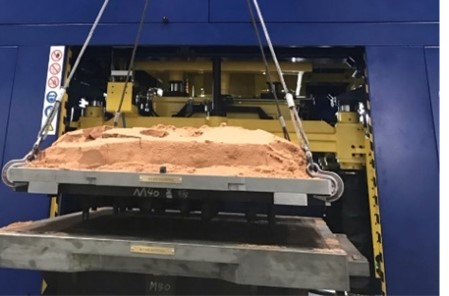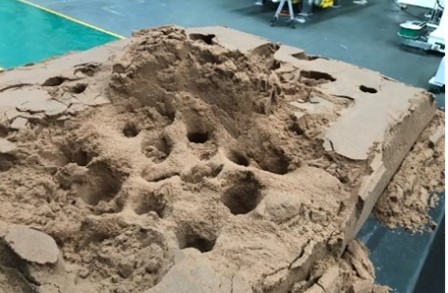

Shooting plate Residual Sand
Images of residual core sand on the top of the shooting plate during core box replacement
Presently, the high-end core shooting machine employs an injection plate cleaning mechanism for sand disposal. However, this approach does not effectively address the waste and pollution issues associated with mixed sand. Additionally, the cleaning mechanism occupies a substantial amount of internal space within the core shooter, and its frequency of use is limited. To manage the waste sand more economically and efficiently, Mingzhi Technology has developed a series of "sand-saving" solutions. These programs have proven to yield significant benefits with a relatively modest investment. The following options are shared for your reference: Option 1. Addition of a sand saving block at the top of the core box shooting plate. In the mold design process, a special sand-saving block is integrated, considering the shooting nozzles positions and lengths. This block is located on top of the shooting plate, where the sand flow is not required during shooting stage to ensure the core quality. It is used not only to save sand but also to guide the sand and to reduce sand spillage during shooting plate disassembly. Overall, it limits the amount of sand used for a specific tooling while improving the production quality.
(section view)
While this method effectively reduces residual sand within the shooting head, concentrated sand shooting positions may still result in unnecessary residual sand. Option 2. Change the internal shape of the shooting head from an inverted cone to a flat shapeThe shooting head may be designed with a "flat-form," by incorporating specialized sand-saving blocks to fill the purposeless cavities within the shooting head. This design aims to minimize the generation and quantity of residual sand.
Inverted cone-shaped shooting head Flat shooting head
(section view)
Option 3. Integrated design of shooting head as part of the tooling To enhance the core shooter's utilization rate and minimize the time spent on waste sand cleaning, Mingzhi Technology upgrades the conventional tooling design approach by integrating the shooting head as part of the tooling. Tailored to the size and shape of each core, a dedicated shooting head is designed for each core box. These shooting heads are securely fastened to the core shooter's shooting tube using a quick-locking device. Integral removable shooting head
Integral removable shooting head
Diagram and Picture
Although this method does not completely solve the problem of waste sand, it can save a great deal of time spent on waste sand cleaning, minimizing the amount of residual sand and contamination of the equipment, thus stabilizing the efficiency of core shooting.
These suggested improvement concepts may be implemented on existing equipment, core boxes, and core design. In comparison, by adapting the shooting head design, a reduction in volume of nonessential core sand of over 50% has been demonstrated, resulting in decreased waste costs and mitigating both equipment and environmental pollution. These sand-saving technologies have already been applied to the MAs and MDs series and the MiCC core equipment from Mingzhi. Upgrading existing MLA+, MLC and MLD series core shooters with these technologies is also possible. For further information regarding the sand saving technology, please feel free to contact Mingzhi: info.leipzig@mingzhi-tech.eu www.mingzhi-tech.eu